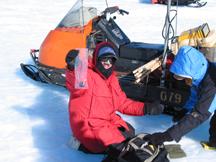
|
|
20 December, 2002
Hi, this is Linda Welzenbach posting for the first time. It's also my first
time in Antarctica, and one of the highlights of my career as a
geologist. So how did I get the opportunity to be apart of this wonderful
team? I applied to ANSMET when I became the Collection Manager of
Meteorites at the Smithsonian's National Museum of Natural History. I help
take care of U.S. National Meteorite collection, which includes over 10,000
from Antarctica, collected by past ANSMET teams over the last 26
years. While the National Science Foundation makes ANSMET expeditions
possible, the Smithsonian along with NASA, provide the care, classification
(identifying and describing the meteorites), and storage of the meteorites,
making them accessible to the global scientific community. This means that
my primary experience with meteorites is in both the laboratory and museum
setting. Now I get to help find them too.
So how did I get this great job? It started with my mineral collecting
hobby (started at age 7) which became my major in college. Geology also
satisfied my need to be outdoors (Isn't Antarctica the ultimate in
outdoors?!), and the field projects were only available thorough additional
graduate education. Just as I was about to receive my Master's, I saw an
advertisement in Geotimes magazine, looking for a graduate who might be
interested in working on a new Geology Hall at the Smithsonian's National
Muesum of Natural History, specifically in the area of minerals. The
lesson here is don't ever leave your hobbies behind. While in graduate
school I acquired research and writing skills, plus I got to take many
classes on topics that really interested me, but it was my love and
knowledge of minerals that enabled me to get the job. Hobbies are for many
folks a second career, or can lead to a primary career. This certainly
applies in my case, as collections are my profession.
Minerals aren't meteorites, but like all rocks, they are made of minerals
and planetary science, which includes the study of meteorites, is a
geological discipline. So with my acquired collection skills and strong
geological background, I was the best candidate to become the Collection
Manager of Meteorites. That was over three years ago now, and thanks to
everyone at ANSMET and the Smithsonian, here I am. While this is a great
honor to me, I bring my experience with seeing a whole collection of
different types of meteorites to the team, helping everyone else recognize
all types of meteorites.
There was a fair amount of pressure as the "whole-rock" expert, to help
everyone get acquainted with meteorites in the field. Not only was I quick
to point out that there were 4 very experienced meteorite hunters (Nancy,
John, Jamie, and Diane), seeing meteorites in a collection setting doesn't
mean I will know what they look like in the wild. Of course my fears were
unfounded. Meteorites really do look different from the rocks that
surround them, even when you are searching through glacial moraine and
there are many hundreds of terrestrial rocks to the one or two
meteorites. As we have collected 138 meteorites as of this posting,
everyone has become an expert meteorite hunter (although I will admit that
I get a warm fuzzy feeling inside when the other team members want me to
verify their find.)
Today was one of the warmest we've had since we got in the
field. Temperatures approached freezing and there was no wind. It's
amazing how warm we felt. Many of us went without jackets for a while
today. We found 19 meteorites under ideal conditions and we were still up
for a game of football when we returned to camp tonight.

Linda Welzenbach holding up her prize (photo by Dante Lauretta).
Contact the TEA in the field at
.
If you cannot connect through your browser, copy the
TEA's e-mail address in the "To:" line of
your favorite e-mail package.
|
